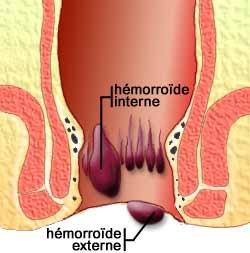Les hémorroïdes
Les hémorroïdes se définissent comme des dilatations artérioveineuses situées sous la muqueuse rectale en forme d’anneaux autour de l’anus. On parle d’hémorroïdes lorsque la taille des « renflements » augmente sous l’action des efforts de poussée et occasionne des symptômes.
Au stade initial, les hémorroïdes se présentent sous forme de nodules invisibles et impalpables au niveau du canal anal. Lorsque le problème s’accentue, ces nodules s’extériorisent temporairement par l’anus souvent lorsque la personne va à la selle. Ils retrouvent ensuite leur position initiale. À un stade plus avancé, les nodules resteront souvent à l’extérieur de l’anus, ils sont alors réellement gênants. Dans ce cas, le sang y stagne. Les hémorroïdes ne se vident plus et restent gonflées de sang.
Exceptionnelles chez l’enfant et assez rares chez les personnes âgées, les hémorroïdes sont souvent dues à la constipation. Elles s’associent souvent à des problèmes hormonaux, à une grossesse, à un accouchement, à l’abus de laxatifs ou à la position assise prolongée sur une surface dure.
Bien souvent, les hémorroïdes résultent d’une congestion de la veine porte (foie) qui retentit en aval sous forme d’hémorroïdes. En médecine chinoise, on dit que l’anus est « l’œil du foie ».
Quand les hémorroïdes sont douloureuses, qu’elles brûlent, gonflent, saignent ou sortent de l’anus, on considère qu’il y a « maladie hémorroïdaire ». Cette pathologie atteint un Français sur trois. La principale cause est la congestion portale du foie qui peut être due à l’alcool ou à une alimentation inadéquate, ce qui entraîne un gonflement des hémorroïdes et peut provoquer une crise.
Les complications sont les douleurs anales, la procidence hémorroïdaire, les rectorragies de sang rouge vif après la défécation, l’ulcération et la thrombose.
Composition du Complexe CFT: ce produit liquide est constitué de 40 % de gemmothérapie et de 60 % de phytothérapie.
Les extraits de bourgeons sont :
- Aesculus hippocastanum : depuis des siècles, on utilise diverses préparations à base de feuilles, de fleurs, de graines et d’écorce de marronnier d’Inde pour traiter des troubles de la circulation veineuse telles que lourdeur et enflure des jambes, varices ou encore hémorroïdes.
- Sorbus domestica : en macérât glycériné, le bourgeon de cormier est principalement considéré comme draineur veineux. Il améliore les varices, les hémorroïdes et les ulcères variqueux.
- Juniperus communis : l’emploi du genévrier remonte à l’Égypte antique, voire même avant. Ces propriétés ont persisté à travers les siècles sans jamais défaillir. Ainsi, ces baies sont particulièrement utiles en cas d’arthrite, de goutte et toutes autres maladies rhumatismales.
- Rosmarinus officinalis : antidouleur reconnu notamment pour les migraines, le romarin permettra de décongestionner les vaisseaux principalement au niveau du foie en raison de son tropisme hépatique.
Les extraits de plantes sont :
- Cynara scolymus : tout le monde connaît les vertus de l’artichaut au niveau hépatique, rajoutons qu’il constitue un traitement utile lors de constipation chronique.
- Cupressus sempervirens : le cyprès agit sur la perméabilité veineuse et lymphatique, et donc sur l’ensemble de la circulation. Cette plante intéressante est donc pour conserver ou retrouver un confort circulatoire, et un certain tonus de façon plus générale.
- Hamamelis Virginiana : cet arbuste originaire d’Amérique du Nord est également appelé noisetier de sorcière. Ses feuilles sont largement employées pour tous les troubles circulatoires. Ses tanins permettent une action veinotonique et ses flavonoïdes ont des propriétés vitaminiques P. L’hamamélis augmente la résistance des capillaires et résorbe les œdèmes veineux. Son action anti-inflammatoire et veinotonique est utile dans le traitement des varices, jambes lourdes et des hémorroïdes.
- Melilotus officinalis : les principaux composants du mélilot sont des coumarines à légère activité anticoagulante, ce qui lui procure une action antithrombotique intéressante. Le mélilot diminue la perméabilité de la paroi et augmente le tonus des vaisseaux lymphatiques, des veines et des capillaires améliorant la microcirculation, ainsi que de la circulation cérébrale et périphérique. Cette action veineuse bénéfique s’étend aux problèmes hémorroïdaires.
- Quercus robur : d’un point de vue général, le chêne est un tonique et un stimulant. Sa richesse en tannin et son écorce astringente, l’ont fait apprécier comme remède efficace pour l’eczéma et diverses autres maladies cutanées. Il est également utilisé avec succès pour soigner les inflammations de l’œil, les hémorroïdes, les engelures et les fistules anales.
- Ruscus aeculatus : le petit houx ou fragon fut aussi longtemps utilisé en Europe pour soulager les menstruations douloureuses, désengorger les gonflements d’origine veineuse, pour traiter la constipation, les troubles urinaires et les douleurs abdominales. Les deux saponosides, la ruscogénine et la néoruscogénine, extraits de cet arbuste ont des propriétés fortement vasoconstrictrices ce qui explique son efficacité dans les divers troubles veineux, notamment l’insuffisance veineuse des membres inférieurs (jambes lourdes et enflées, varices, etc.) et les hémorroïdes.
- Taraxacum dens leonis : en augmentant l’écoulement de la bile et stimulant les foies paresseux, le pissenlit est un excellent entraîneur préviendra l’apparition de calculs biliaires et rénaux.
- Vitis vinifera : Cette vigne ligneuse et grimpante s’est avérée excellente pour les problèmes circulatoires tels que jambes lourdes, varices, hémorroïdes ou encore troubles circulatoires liés à la ménopause. Les anthocyanosides couleur rouge sang permette de diminuer la perméabilité capillaire et d’augmentant leur résistance, diminuant ainsi la stase veineuse. Cette action est renforcée par ses tanins, astringents et vasoconstricteurs, qui favorisent le retour veineux. Parmi ces tanins, les proanthocyanidols ont une action contre les radicaux libres.
Conseil d’utilisation du Complexe CFT:
En période de crise de nausées, vomissement, indigestions, coliques : gouttes 3x/jour dans un verre d’eau avant les repas (enfants : 15 gouttes 3x/j)
En usage chronique : difficultés de digestion, reflux acide, aérophagie, flatulences et ballonnements : 10 gouttes 3x/jour dans un verre d’eau avant les repas (enfants : 5 gouttes 2x/j)




